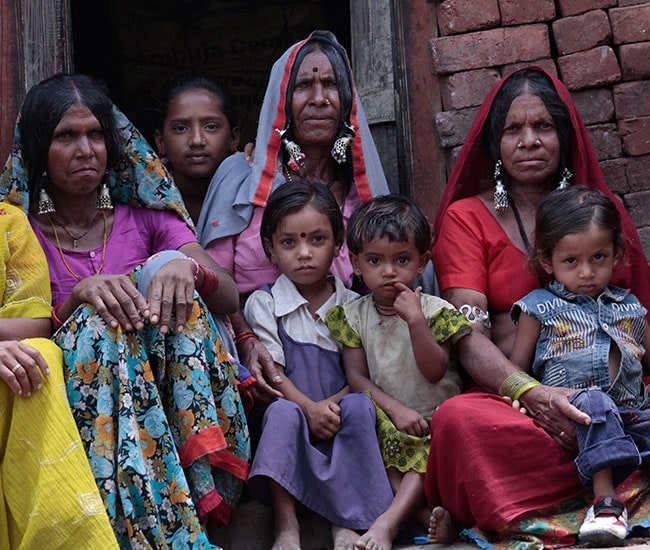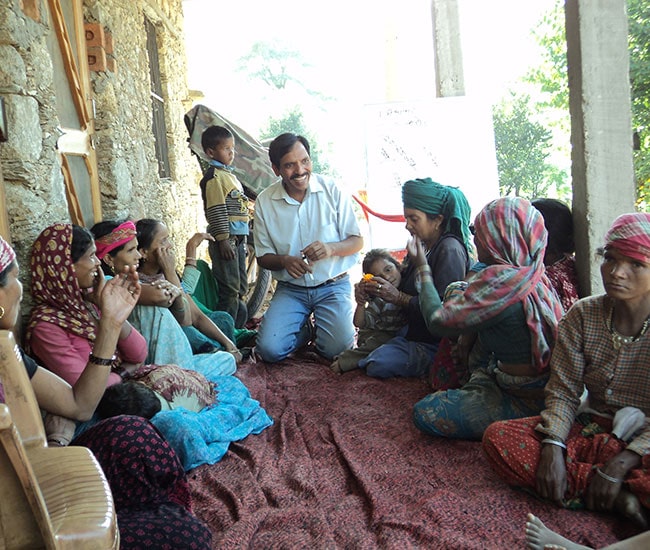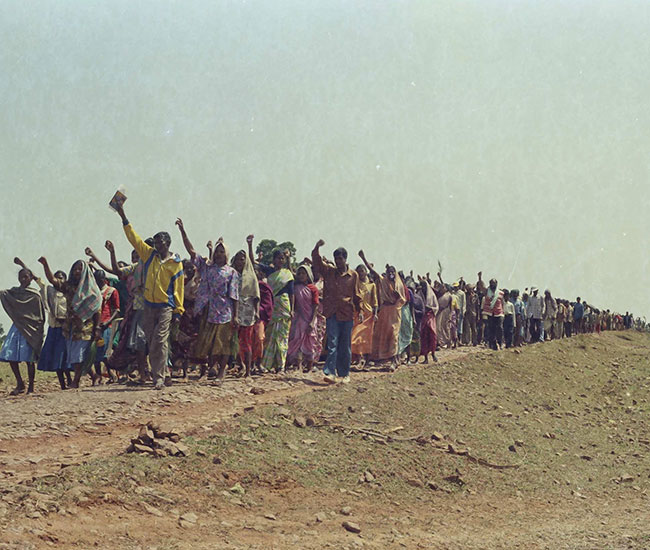
Shramjeevi Sangathana
Till the early 1990s the Marathwada region of Maharashtra was witness to several cases of atrocities against dalits, apart from everyday indignities, and exploitation in issues of work and wages. Political, economic and social power was vested in the hands of a few upper caste families, all others being at their mercy. The village was a highly segregated space, and was planned in such a way that the upper caste houses lay to the west side, and the lower caste houses to the east, so that the wind (whose general direction was from west to east) reaching the upper caste area would not be ‘polluted’ by contact with people from the lower castes.
The houses of dalits were cramped, made of mud, hay and leaves and were often worse off than the animal sheds of higher castes. There were separate wells for the use of different castes, and dalits were barred from entry into temples. In many hotels, there were separate cups and plates kept for serving dalits. There was no occupational mobility, and people were bound to do caste based work, the most menial falling in the lot of the dalits who had no negotiating power. With in the dalit community and other oppressed groups, people seemed to have accepted the situation as a given, and did not feel that they could raise their voice and protest.
When the Campaign for Human Rights was initiated in 1990 in the Marathwada region, the first and foremost aim of the groups and individuals associated with it was to change this mindset, to forcefully get across to people that what was happening was in complete violation of their basic rights as human beings. As a priority they worked with the Matang community, the most oppressed amongst the dalits, on eradicating untouchability and putting an end to atrocities. Then by taking up issues related to the Employment Guarantee Scheme (EGS on which MGNREGA was modeled) like minimum wages, they widened their reach to include other backward castes and poorer sections of the upper castes.
Dashrath Jadhav was part of CHR from the very beginning, and soon built up an affiliated identity in the form of a trade union by the name of Shramjeevi Sangathana (Marathwada Vibhag). Though it was registered only in 1996, as a part of CHR the sangathan was active in Latur district since the early 1990s, taking up specific cases of discrimination, filing FIRs against the perpetrators and mobilizing people to collectively fight against injustice. (Movement in Village Patoda) By the mid 1990s, their tireless work resulted in a significant reduction in caste based atrocities. While internal conflicts caused CHR to break up, the Shramjeevi Sangathana continued on its path, building a mass base in 4-5 blocks around Udgir.
One of the sangathan’s most significant achievements has been in regularizing gairan land. Each village in this region has some land designated as grazing or gairan land. There have been several government rulings stating that if landless dalits encroach on this land and cultivate on it, it should be given to them for agriculture. However, in many cases there are obstacles in the way of getting the land in their name legally, especially in encroachments that happened after 1991. Before 1991, the number of encroachments was much lesser because people were scared of retaliation from other villagers. The sangathan has been instrumental in helping families with the administrative procedures as well as with giving them the confidence to stake their claim on the land. (Vanjarwadi)
By the early part of the new millennium, after ten years of concentrated work, the problems of caste based atrocities and discrimination had almost vanished. Now, even if a stray incident happened, the social, political and economic climate had been transformed to such an extent that it could be dealt with through letters and discussion with the officials. (Sangathan and the Police) With the improvement of the socio-economic status of the dalits, issues such as education, health, employment opportunities etc came to the fore. Meanwhile there were some internal conflicts within the sangathan that led to the work being disrupted and discontinued for a few years. In 2008, once again the cadres felt the need to reinvigorate the collective and infuse it with fresh energies. While continuing their work with gairan, in this second phase, the sangathan has focused on fighting exploitation in PDS, creating awareness about MGNREGA, and insurance, pension and scholarship schemes of the government, and ensuring BPL surveys are done properly. Education has continued to be a key issue throughout, the sangathan being involved with the village education committees, having regular discussions and playing a monitoring role in matters such as drop outs, quality of education, mid day meals etc. (Brick Kiln Schools)
The Shramjeevi Sangathana is active in over 200 villages in Udgir, Devni, Jalkot, Ahmedpur and Chakur blocks of Latur District. The core group has five members, three of who are from Ekurka village. The sangathan always starts its engagement with a new village through an issue of a group or individual in that village and then goes about mobilizing people. Both a person and his/her spouse are requested to become members of the sangathan and are issued identity cards that come in quite handy in dealing with authorities. In many villages participation of women in the sangathan’s activities is higher than that of the men. In each of the villages there are 2-3 committed volunteers who keep in touch with the people and try to solve smaller problems at the village level through the sangathan’s village committees. When a major issue comes up that needs to be taken up through a large meeting or rally, people come from villages all around to show support and solidarity.
While the sangathan has been working with effective governance in recent years, there is awareness that they should not be reduced to a delivery mechanism for government schemes. The idea is not to get things done for people, but to raise political consciousness so that they see what they can achieve through collective action. The sangathan’s larger aim is to bring a new order where leaders emerge from and as true representatives of the oppressed classes and castes breaking the hegemony of the small minority of the rich and powerful.
Stories
Movement in Village Patoda
In 1991, in village Patoda of Jalkot block there was an instance of social boycott against the dalit community because two educated youth from amongst them had ‘dared’ to draw water from the well reserved for upper castes. The well meant for dalits had been contaminated and as a concession, they had been allowed to use the upper caste well. However, they could not access it directly but had to wait for a person from an upper caste to pour the water for them. Since the two men had not obeyed the rules, there was a furor in the village followed by people getting beaten up and finally the social boycott. When Dashrath and others in the sangathan came to know about this, they took up the issue in a big way and organized people from many nearby villages around it. Initially people were too afraid to come out of their homes even to attend a meeting. So the sangathan members would go to people’s home and have discussions. Slowly, people started picking up courage. Not only dalits, but OBCs and muslims also joined in the protests. They filed an FIR against the people who had beaten up the dalit boys. Then they called for a big meeting attended by hundreds, and finally the upper caste individuals who had indulged in violence were arrested. This was a huge turning point that made people believe that they have a right to speak up and that their voices will be heard.
Vanjarwadi
Vanjarwadi was a small hamlet comprising 11 families staying at the bottom of a hill under precarious cliffs. They were landless labourers working for a landlord who had allowed them to live there as it was close to his fields. However, it was not accessible by road, and there was always the danger of the overhanging rocks falling and crushing the people and their homes. When the sangathan became aware of their living conditions, they were appalled. The 8-10 karyakartas who had gone there for the meeting offered to pick up all their things then and there and move them to the vast unclaimed gairan land of neighbouring Tondar village.
People were scared at first wondering how they could just take over that land, but they took the risk and went, taking up small plots of land for building houses and for agriculture. Initially there was some resistance from the people of Tondar village, but since their gairan land stretched over 1000 hectares and was lying unused, they finally agreed. Some sangathan workers stayed in the new village for a couple of months and fought to get water and electricity. Later the Panchayat Samiti got pucca houses built for the poorest families through the Indira Awas Yojana. The first 11 families who went there have got the land in their name. Following their move in 1993, as many as 150 landless families from nearby villages have come there and marked out plots for themselves. There is also a primary school on the gairan land with a proper building and amenities where the children of Vanjarwadi study.
Sangathan and the Police
Even more than the upper castes, the greatest source of fear for the oppressed communities were the police who seemed to wield unlimited amounts of power. Even people’s groups were afraid to go against them for it was a much safer and comfortable option to keep on their good side. In Marathwada, Shramjeevi Sangathana was the only group to openly protest against police atrocities and hold rallies against them. This went a long way in establishing in people’s minds that the police were public servants and not the overlords they were often acting as. People also internalized the idea that they do not have to be reduced to servility in their interactions with the police.
However, the stand of the sangathan has always been that they will raise their voice against injustice. So they have not hesitated in taking up rallies in favour of the police demanding higher pay, better working conditions, proper housing etc., and also opposing politically motivated transfers of honest officers. This principled position has won them the respect and trust of the administration and people at large.
Brick Kiln Schools
There are several small scale brick kilns dotting the area around Udgir. They are seasonal kilns operating between October and May. Usually families are paid in advance around Diwali when they need money, and then made to work for the next 7-8 months. From 2000 to 2002 the sangathan ran 5-6 informal schools for children working in these kilns. The children were of different ages and at different levels, but this effort gave them an opportunity to stay in touch with their studies. Some people supported the sangathan by giving classroom space, and in other cases they held classes under a tree. An ngo helped with books, black boards and teaching materials. Through the government’s mid day meal scheme they got shopkeepers to give grains for the children’s food. Later these children were allowed to take exams in a regular school based on their attendance in the sangathan’s informal schools. The initiative had to be discontinued because of lack of funds to pay the teachers.



